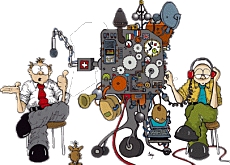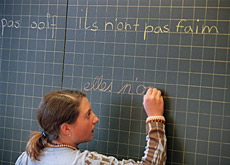New book decodes Swiss German

It won't help much on a desert island, but a new book, Hoi – your Swiss German survival guide, is an entertaining introduction to the dialect.
It is designed for English speakers confronted with the oral language, either as residents or tourists, especially those “with long cables”.
It is also intended for non-native speakers of Swiss German who are slow to catch on, which is, as the book explains, the meaning of having “a long cable”.
The text is kept to basic explanations and translations, letting the accompanying illustrations humorously express the frustration of getting to grips with Swiss German.
“Everything started when I signed up to learn German,” says Anglo-Colombian cartoonist, Sergio Lievano, who lives near Zurich.
“I thought the key thing was to learn standard German. Nicole Egger [co-author] was my first teacher,” Lievano remembers. “I started to illustrate the funny situations of foreigners struggling with Swiss German and struggling with the norms and rules of Switzerland.”
Still surviving
The book begins with a short summary of the history of the language, describing what sets it apart from standard German and why it has survived despite being spoken only by a few million people.
One illustration shows a Swiss German spitting words into an unwieldy mechanical translating contraption, while another depicts external language influences breaking apart upon impact with the Swiss Alps.
Only a few fragments manage to overcome the mountainous obstacle to find their way into the Swiss valleys.
“I realised a lot of my students got frustrated when they found that [standard] German is not the language used here,” says Egger, a linguist.
“We wanted to give people the opportunity to become familiar with basic Swiss German and to feel at home in Switzerland,” she adds. “The key to a Swiss-German’s heart is Swiss German, not German.”
Part two of the book, Survival Kit, is dedicated to grammar and everyday situations, which are broken down into key words and phrases.
Surprisingly, Hoi is one of the few non-academic books on Swiss German conceived solely for language learners.
Crossword puzzle
“A Swiss-German dictionary?” a bookshop sales clerk is asked: “Yes, upstairs in the puzzle and crossword section,” she answers in the cartoon illustrating the page on “key survival shopping phrases”.
“All of the drawings are based on my day-to-day experiences,” Lievano says.
“Foreigners struggle at the post office, for example, and I try to capture their expressions at these moments. As a foreigner, you don’t even understand the most basic things; at least that was my case. That frustration was the biggest motivation for my illustrations.”
Amateur linguists or people with a decent knowledge of French as well as English will find the book peppered with words with which they are already familiar.
Swiss Germans prefer merci to danke schön when saying thanks, and use the French word vélo for bicycle, instead of the German Fahrrad.
Playing with English
Yet English is gaining the high ground, and not only in the business world: Cool, meeting, forward and attachment (e-mail terms), teeni (teenager), game-ah (play video games), and schoot-ah (football from “to shoot”).
“It’s dominant in business and science as well as in sports, music and lifestyle,” Egger says.
“You take the English root but the Swiss-German grammar, such as Swiss-German endings. For example, fooda (eat). Food is the root but the way it’s used, the morphology, is all Swiss German. That’s very common,” she continues.
“Sometimes people know the English word, but not the German. Germans have done a better job translating English words – they use Rechner for computer for example – where the Swiss don’t even bother.”
Part three is devoted to slang and Swiss-German idioms, many of which the authors claim are unique to Switzerland.
Buried dogs
If a Swiss German wants to get to the crux of the matter, he needs to know “where the dog is buried”, the book says.
Alternatively, people who do the unexpected much to the dismay of others are not asked if they have lost their minds, but whether they “have crossed on the red light”.
The authors warn, however, that Swiss German is “a moving target” as the language continues to evolve and change.
Egger says Switzerland’s large Kosovo-Albanian population, particularly the second generation of Kosovars living in the country, is greatly influencing the way the language is spoken.
“A lot of young people speak what we call ‘Albanian Swiss German’,” Egger says.
“There are hardly any new words coming into the language but the rhythm, the whole syntax is influenced. It’s hip and cool to speak like that.”
The book is published by Bergli Books in Basel (see related sites).
swissinfo, Dale Bechtel
About two-thirds of the Swiss population speak Swiss German.
A little over 20% speak French, with 6.5% claiming Italian as their first language.
Various languages account for the other 10%.
English is only claimed as the mother tongue of about 1% of the population, yet English is continuing to influence Swiss German.

In compliance with the JTI standards
More: SWI swissinfo.ch certified by the Journalism Trust Initiative



You can find an overview of ongoing debates with our journalists here. Please join us!
If you want to start a conversation about a topic raised in this article or want to report factual errors, email us at english@swissinfo.ch.